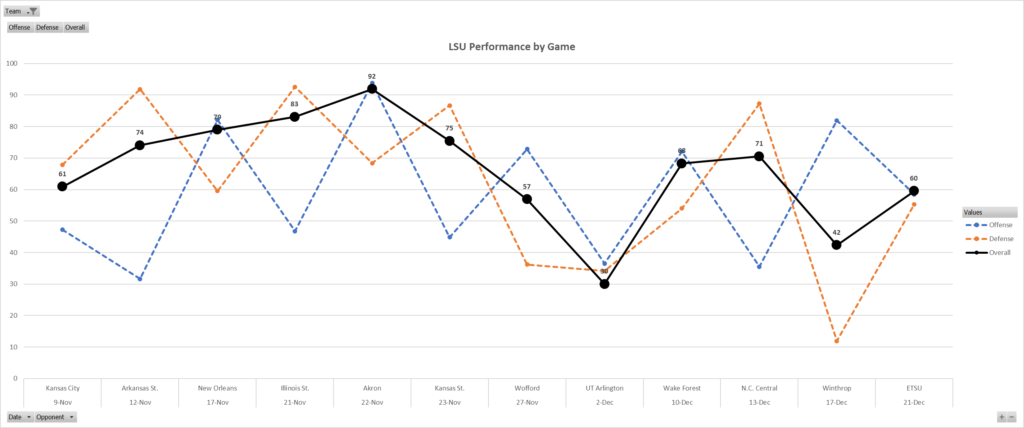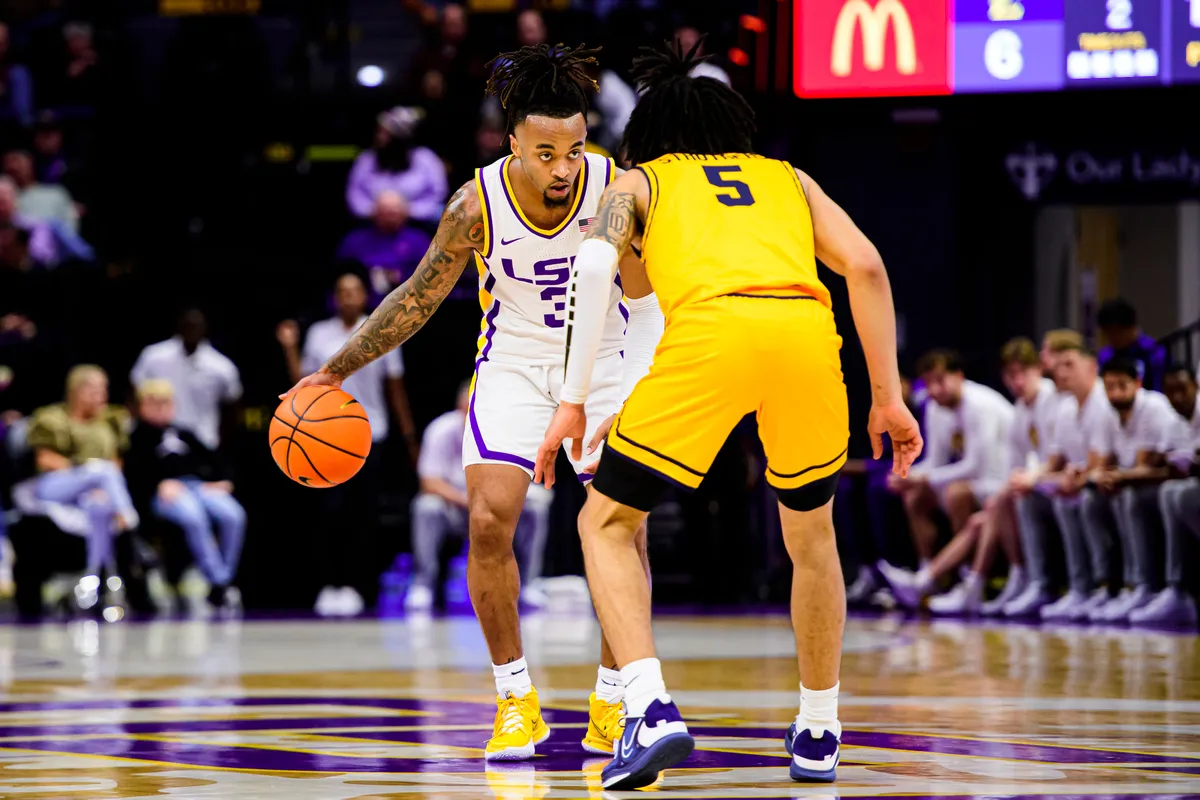Arkansas opens SEC play on the road against LSU. It’s a critical game, since the Alabama and Auburn games are coming up, and the Hogs really would like a 2-0 start to SEC play going into those.
The Razorbacks will be without Nick Smith, who continues to rest his right knee. Because Arkansas gets a full week off after this game, I still think there’s a good chance we see plenty of Smith this season. Resting Smith for this game will give him two and a half weeks off until the Mizzou game on January 4th. After that, the Hogs are into the two-a-week grind, so if Smith doesn’t come back for that one, then it’s time to be concerned that he’s either not going to play or not ever going to be healthy in a Razorback uniform.
Meet the Tigers
The Will Wade era (predictably) ended in disaster last season, so LSU is starting over. The Tigers hired Murray State coach Matt McMahon and overhauled their roster. Given the looming threat of NCAA action over LSU’s rampant and blatant cheating under Wade, the Tigers actually made out pretty well to get a solid coach and have a decent roster this season.

LSU’s 11-1 record is reflective of a weak schedule. The Tigers’ lone loss is to a decent Kansas State team, but none of their wins are impressive, and they struggled with Wofford, UT Arlington, and East Tennessee State.

That schedule ranks just 276th nationally, which is why Arkansas appears to be much better despite both teams having 11-1 records.
The momentum stat at the bottom is also interesting. LSU’s best games were earlier in the season, and they haven’t been as good of late:

All four of the Tigers’ game grades of 75+ came in a four-game stretch before Thanksgiving, with three of those games in the Cayman Island Classic. Since then, LSU has yet to have a performance graded at 75 or higher. By contrast, Arkansas has graded at 75+ in six of their last seven dating back to the San Diego State win in Maui.
Model pick: Arkansas 74, LSU 66.
Personnel
We’re switching things up for this preview and starting with personnel, as it is good to know names when you start seeing team stats. We’ll look at the profiles and advanced stats of the eight guys who play the most minutes for the Tigers, beginning with starters.
The LSU roster is interesting. Several guys came with McMahon from Murray State, and they are all solid defenders and the main two rarely turn the ball over on offense. That’s basically how Murray State won last year and how McMahon wants to win at LSU. The rest of the roster is… not that. Almost everyone else turns it over too much (a few are turning it over way too much) and all of the non-Murray transfer guards are subpar defenders.
KJ Williams, PF, 6’10
- Box Score Contribution: +9.1 (1st)
- RAPM: 99 (2nd)
- Offense RAPM: 99 (1st)
- Defense RAPM: 86 (3rd)
Williams – a Murray transfer – is the guy on offense. He sports a team-high 28% usage, which makes his eye-popping 120.2 offensive rating even more impressive. He’s shooting 63% EFG, leads the team in total rebounding rate (16%), and only turns the ball over on 12% of possessions. For good measure, he’s an excellent 23 of 46 (50%) from beyond the arc. He’s more of a finesse player – so he doesn’t get to the line much – while his frontcourt mate is the more traditional SEC ruffian. Expect Jordan Walsh to primarily guard him, which will be a big test given the three-inch height difference.
Derek Fountain, PF, 6’10
- Box Score Contribution: +2.7 (2nd)
- RAPM: 99 (1st)
- Offense RAPM: 82 (4th)
- Defense RAPM: 100 (1st)
A transfer from Mississippi State, Fountain is the low-post banger who is likely to draw a defensive assignment from Makhi Mitchell. Offensively, he’s a low-usage putback machine who is tied for the team lead in offensive rebound rate (13%) and shoots 0.73 free throws per field goal, which is really high. He’s shooting 71% EFG with almost all shots coming around the rim. He grades even better as a defender, where he leads the team in steal rate and is a decent shot blocker. His high turnover rate (21%) is the main knock against him, and he’s also a bit foul-prone, which limits his minutes.
Adam Miller, SG, 6’3
- Box Score Contribution: -1.1 (7th)
- RAPM: 90 (3rd)
- Offense RAPM: 88 (2nd)
- Defense RAPM: 81 (5th)
LSU’s forwards are very dangerous, but the backcourt is a potential weak point. The Illinois transfer grades as the best guard on the team, although the advanced stats say most of his contributions aren’t captured in the box score. He’s high-usage on offense (23%), with about two-thirds of his shots coming from beyond the arc. He’s only shooting about 30% on those, which is contributing to his low BPM Contribution rank, though a look through the stats and at some film shows that a not-insignificant number of his missed shots are rebounded by LSU forwards, which might help explain why LSU is pretty good when he’s on the floor.
Cam Hayes, PG, 6’2
- Box Score Contribution: +2.7 (3rd)
- RAPM: 89 (4th)
- Offense RAPM: 86 (3rd)
- Defense RAPM: 81 (6th)
Hayes is a much better shooter than Miller, totaling 67% EFG and ranking third on the team in offensive rating, behind Williams and Fountain. About half his shots will be from beyond the arc. He’s a better passer than Miller but also more turnover-prone. He is not an elite defender.
Justice Hill, PG, 6’0
- Box Score Contribution: -0.4 (5th)
- RAPM: 76 (6th)
- Offense RAPM: 41 (7th)
- Defense RAPM: 91 (2nd)
The Little Rock native and one-time Arkansas commit is another one who followed his coach from Murray State. He’ll be the primary ballhandler for the Tigers. Right now, he’s a bit of a liability on offense, as he shoots too much for a guy sitting on 39% EFG. He’s a good passer and he rarely turns the ball over. His real skill is as a defender, where he’s an all-around solid perimeter and on-ball defender.
Trae Hannibal, SG, 6’2
- Box Score Contribution: -0.5 (6th)
- RAPM: 51 (8th)
- Offense RAPM: 16 (8th)
- Defense RAPM: 85 (4th)
Hannibal is another Murray State transfer who is off to a rough start on offense but sees minutes due to his defense. He grades as the Tigers’ worst regular player thanks to his low shooting percentage and high turnover rate. He’s not a 3-point shooter, meaning that he’s a 6’2 guard who is reliant on getting to the rim. Good luck. He’s excellent at getting to the line – he takes almost one free throw per field goal and leads the team in that ratio – but he’s only a 72% foul shooter. He’s also incredibly turnover-prone (29%). Defensively, he’s much stronger; like his former Racer teammate Hill, he grades as a solid perimeter and on-ball defender.
Jalen Reed, SF, 6’10
- Box Score Contribution: -1.3 (8th)
- RAPM: 65 (7th)
- Offense RAPM: 70 (7th)
- Defense RAPM: 53 (8th)
Reed is very similar to Fountain: a low-post player who draws a ton of fouls but also turns it over a ton. Reed isn’t as good of a rebounder (offensive or defensive), is even more turnover-prone (team-worst 31%), and grades much worse as a defender.
Mwani Wilkinson, SF, 6’5
- Box Score Contribution: -0.1 (4th)
- RAPM: 83 (5th)
- Offense RAPM: 75 (5th)
- Defense RAPM: 80 (6th)
Whoa, a guy that was in Baton Rouge last year! Wilkinson pulled his name out of the portal and came back to LSU. Wilkinson’s 12% usage rate is tiny, which means the Tigers are basically never trying to get him the ball. Most of his shots are 3-pointers and he’s actually hitting 44%, granting him 3-point sniper status. He’s purely a perimeter player who presents no threat of getting to the rim. He’s a decent defender who competes for rebounds.
When LSU has the ball

LSU’s offense is balanced. They play with moderate pace, going fast only when the defense allows them to. They get some production by fast-breaking off turnovers, but otherwise, halfcourt is where this game will be won or lost, as the Hogs are very good at preventing opponents from running.

The offensive numbers here are weird. LSU is just a really average team. They are not bad at anything, but also not great at anything.
They create shots through offensive rebounds (112th), which you would expect for a team who will use three 6’10 guys. They are also decent at getting to the line (127th). Their turnover rate is very mediocre (171st) but not horrible. As discussed above, the main two guys with the ball – Hill and Williams – will avoid turnovers, but the supporting cast will give the ball away like candy.
In terms of turning shots into points, they are above-average at both getting to the rim (139th) and finishing there (101st). That’s really where they are most dangerous. They don’t create a lot of 3-point shots (193rd) and their best 3-point shooters rarely shoot, making their 100th-ranked 3-point shooting percentage unlikely to be a major threat.
When Arkansas has the ball

LSU’s defense is similar to many Arkansas has faced this year. It’s a man-to-man scheme that wants to force long halfcourt possessions. But the Tigers are different from a team like Oklahoma in that they are vulnerable to simply being beaten down the floor. The Tigers are 198th in total transition rate, 247th in transition scoring rate, and 291st in transition scoring rate off of rebounds. If you can beat all the 6’10 guys down the floor, you can get an easy bucket at the rim.
When the Tigers are able to force a halfcourt set, they do a good job of forcing long possessions (67th) and getting stops on those possessions (27th in halfcourt defensive efficiency, 30th in halfcourt floor percentage).

LSU does a nice job of not fouling, securing defensive rebounds, and defending shots at the perimeter. They don’t block a ton of shots (the threat of a shot block is often just as valuable as blocking a shot), so opponents who are able to get near the rim can often convert (240th in rim shooting defense).
Winthrop and Wofford both bombed them with 3-point attempts, as you’d expect from small, guard-oriented teams playing against a team with such a tall frontcourt. Arkansas’ tall guards might serve as a reality check on these numbers: is LSU really good at preventing opponents from getting inside, or are those numbers a product of a weak schedule filled with small teams? We’ll find out.
Keys to the Game
- Beat them down the floor. LSU’s halfcourt defense is a team strength, and the Tigers will have a chance to win if they can force the Hogs into long halfcourt sets. But they’ve had issues stopping opponents who want to run, and the Hogs definitely want to run.
- Stop KJ Williams. Sometimes, it’s simple. Williams is an absolutely dominant player for LSU and their only serious offensive threat, though Cam Hayes is pretty good too. If the Hogs can defend him and take him out of his element, then LSU likely lacks the firepower to keep up.
Thanks for reading! Be sure to follow us on Twitter and on Facebook.
The latest from Fayette Villains, straight to your inbox
Enter your email to subscribe and receive new post alerts and other updates. You can unsubscribe at any time.
